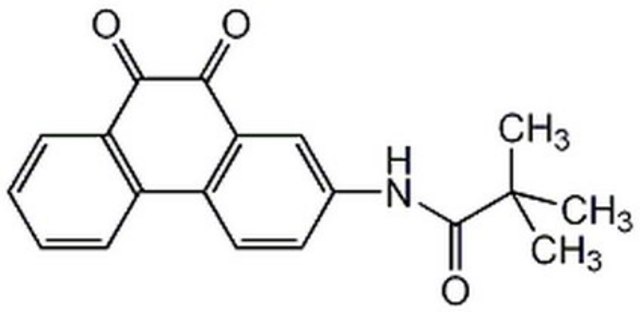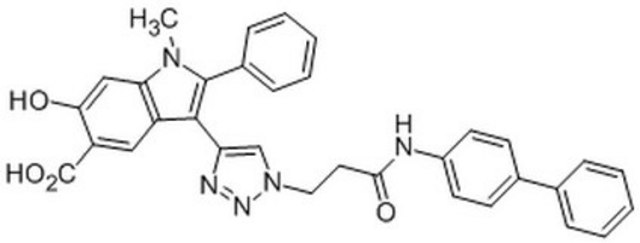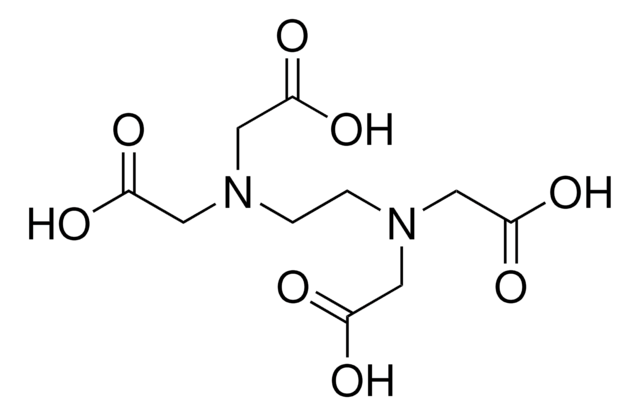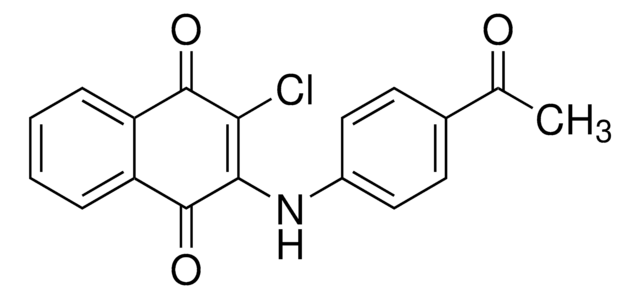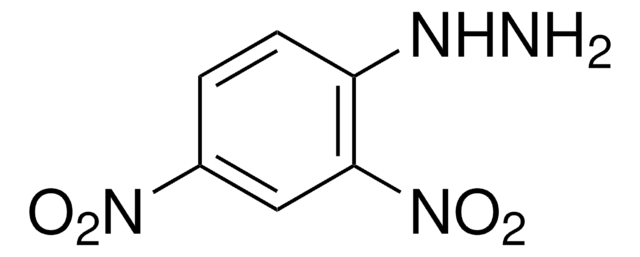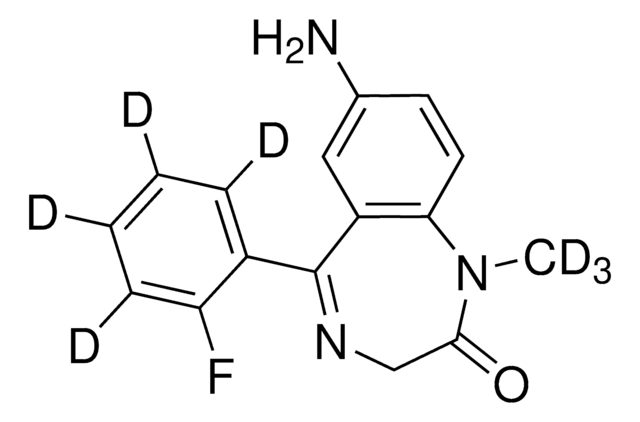All Photos(1)
Synonym(s):
CD45 Inhibitor VI, 2-(4-Acetylanilino)-3-chloronaphthoquinone, Compound 211, Protein Tyrosine Phosphatase CD45 Inhibitor VI, PTP Inhibitor XXXII
Empirical Formula (Hill Notation):
C18H12ClNO3
Recommended Products
Assay
≥98% (HPLC)
Quality Level
form
powder
manufacturer/tradename
Calbiochem®
storage condition
OK to freeze
protect from light
color
orange
solubility
DMSO: 25 mg/mL
storage temp.
2-8°C
General description
A cell-permeable chloronaphthoquinone compound that potently inhibits CD45/PTPRC tyrosine phosphatase activity (IC50 = 290 nM) in a non-substrate-competitive and irreversible manner via targeting an allosteric pocket at the D1-D2 domains interface. Exhibits good selectivity over MKPX, PRL-2, PTP1B/PTPN1, TC-PTP/PTPN2, SHP-1/PTPN6, PEP/PTPN22, LAR/PTPRF, and PTP-Sigma/PTPRS (IC50 >40 µM). Shown to reduce T cell receptor-mediated activation of Lck, Zap-70, MAPK, and IL-2 production in primary T cells and effectively block human Lck pY-394 dephosphorylation in Jurkat, but not CD45-deficient J45.01 line, reducing cellular metabolic activity without affecting viability. Displays immunosuppressive properties against footpad swelling in a murine modle of delayed type hypersensitivity among C57/BL6 mice even when administered (3 mg/kg, i.p) after early onset of inflammation. However, it does not clear existing edema when applied to mice with fully developed inflammation.
A cell-permeable chloronaphthoquinone that potently inhibits CD45/PTPRC tyrosine phosphatase activity (IC50 = 290 nM; substrate = 1 mM pp60-src pY-527 peptide) in a non-substrate-competitive, irreversible, and selective manner via targeting an allosteric pocket at the D1-D2 domains interface away from the substrate-binding/catalytic site, exhibiting little potency toward murine PEST or eight human phosphatases (IC50 >40 µM against pNPP hydrolysis by MKPX, PRL-2, PTP1B/PTPN1, TC-PTP/PTPN2, SHP-1/PTPN6, PEP/PTPN22, LAR/PTPRF, and PTP-Sigma/PTPRS). Shown to increase human Lck pY394 phosphorylation level in Jurkat cells (by 40% in 24 h; 0.5 µM), but not CD45-deficient J45.01 line. Likewise, drug treatment effectively suppresses induction of Lck pY394, Zap-70 pY319, pErk1/2 phosphorylations and IL-2 release in primary murine splenocyte cultures upon T-cell activation (0.5 µM for 48 h) via TCR cross-linking with concomitant reduced metabolic activity (by MTT assay), but not cell death (by Trypan Blue exclusion). Single intraperitoneal injection (3 mg/kg) administered either 1 h or 3 d post Ovalbumin-/OVA-challenge (1 µg /footpad) among OVA-sensitized mice effectively prevents footpad swelling 6 d post challenge (<0.05 mm vs. >0.3 mm, respectively, with or without treatment) in delayed type hypersensitivity (DTH) tests in vivo. Exhibits no detectable cytotoxicity in KB or HEK293 cultures (0.5 µM for 24 h), while a 50% lymphocytes reduction is reported in mice 24 h post 3 mg/kg i.p. dosage with no other apparent adverse effects.
Biochem/physiol Actions
Cell permeable: yes
Primary Target
CD45
CD45
Reversible: no
Packaging
Packaged under inert gas
Warning
Toxicity: Standard Handling (A)
Reconstitution
Following reconstitution, aliquot and freeze (-20°C). Stock solutions are stable for up to 3 months at -20°C.
Use only fresh DMSO for reconstitution.
Other Notes
Perron, M., et al. 2014. Mol. Pharmacol.85, 553.
Legal Information
CALBIOCHEM is a registered trademark of Merck KGaA, Darmstadt, Germany
Signal Word
Warning
Hazard Statements
Precautionary Statements
Hazard Classifications
Aquatic Acute 1 - Eye Irrit. 2 - Skin Irrit. 2 - STOT SE 3
Target Organs
Respiratory system
Storage Class Code
11 - Combustible Solids
WGK
WGK 3
Flash Point(F)
Not applicable
Flash Point(C)
Not applicable
Regulatory Information
新产品
Certificates of Analysis (COA)
Search for Certificates of Analysis (COA) by entering the products Lot/Batch Number. Lot and Batch Numbers can be found on a product’s label following the words ‘Lot’ or ‘Batch’.
Already Own This Product?
Find documentation for the products that you have recently purchased in the Document Library.
Our team of scientists has experience in all areas of research including Life Science, Material Science, Chemical Synthesis, Chromatography, Analytical and many others.
Contact Technical Service